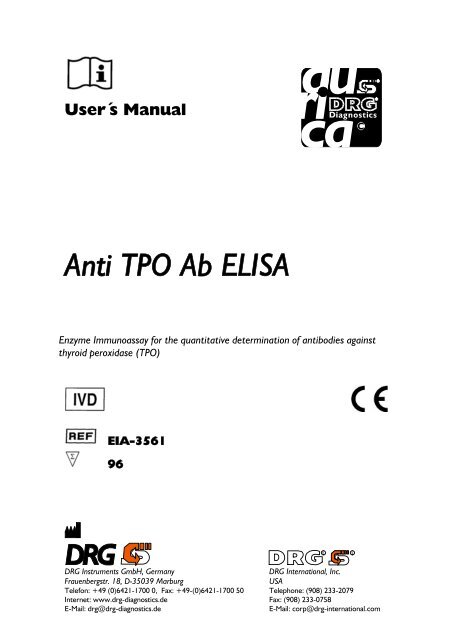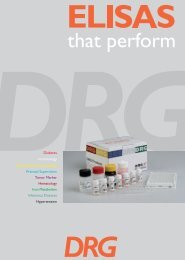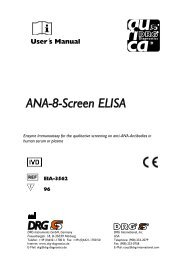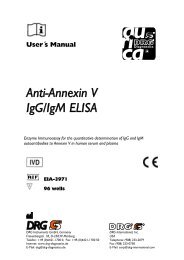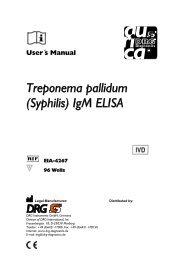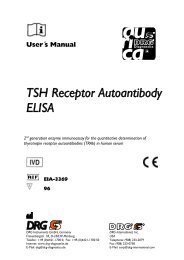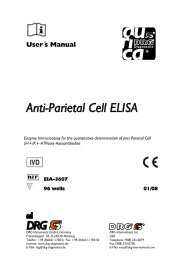User´s Manual Anti TPO Ab ELISA - DRG Diagnostics GmbH
User´s Manual Anti TPO Ab ELISA - DRG Diagnostics GmbH
User´s Manual Anti TPO Ab ELISA - DRG Diagnostics GmbH
You also want an ePaper? Increase the reach of your titles
YUMPU automatically turns print PDFs into web optimized ePapers that Google loves.
<strong>User´s</strong> <strong>Manual</strong><br />
<strong>Anti</strong> <strong>TPO</strong> <strong>Ab</strong> <strong>ELISA</strong><br />
Enzyme Immunoassay for the quantitative determination of antibodies against<br />
thyroid peroxidase (<strong>TPO</strong>)<br />
EIA-3561<br />
96<br />
<strong>DRG</strong> Instruments <strong>GmbH</strong>, Germany <strong>DRG</strong> International, Inc.<br />
Frauenbergstr. 18, D-35039 Marburg USA<br />
Telefon: +49 (0)6421-1700 0, Fax: +49-(0)6421-1700 50 Telephone: (908) 233-2079<br />
Internet: www.drg-diagnostics.de Fax: (908) 233-0758<br />
E-Mail: drg@drg-diagnostics.de E-Mail: corp@drg-international.com
<strong>Anti</strong> <strong>TPO</strong> <strong>Ab</strong> <strong>ELISA</strong> EIA-3561<br />
Version 4.0<br />
Effective, May 2010 (February 2008)<br />
Please use only the valid version of the package insert provided with the kit.<br />
Verwenden Sie nur die jeweils gültige, im Testkit enthaltene, Arbeitsanleitung.<br />
Si prega di usare la versione valida dell'inserto del pacco a disposizione con il kit.<br />
Por favor, se usa solo la version valida de la metodico técnico incluido aqui en el kit.<br />
Table of Contents / Inhaltsverzeichnis / Tabella die Contenuti / Tabla de Contenidos<br />
1 NAME AND INTENDED USE ................................................................................................................... 2<br />
2 SUMMARY AND EXPLANATION OF THE TEST .................................................................................... 2<br />
3 PRINCIPLE OF THE TEST....................................................................................................................... 3<br />
4 WARNINGS AND PRECAUTIONS........................................................................................................... 3<br />
5 CONTENTS OF THE KIT ......................................................................................................................... 4<br />
6 STORAGE AND STABILITY..................................................................................................................... 4<br />
7 MATERIALS REQUIRED.......................................................................................................................... 4<br />
8 SPECIMEN COLLECTION, STORAGE AND HANDLING ....................................................................... 4<br />
9 PROCEDURAL NOTES............................................................................................................................ 5<br />
10 PREPARATION OF REAGENTS ............................................................................................................. 5<br />
11 TEST PROCEDURE................................................................................................................................. 6<br />
12 INTERPRETATION OF RESULTS........................................................................................................... 6<br />
13 PERFORMANCE CHARACTERISTICS................................................................................................... 7<br />
14 LIMITATIONS OF PROCEDURE ............................................................................................................. 8<br />
15 INTERFERING SUBSTANCES ................................................................................................................ 8<br />
16 REFERENCES/LITERATURE.................................................................................................................. 9<br />
1 CONTENUTO DEL KIT........................................................................................................................... 10<br />
2 AVVERTENZEE PRECAUZZIONI.......................................................................................................... 10<br />
3 CONSERVAZIONE E STABILITÁ .......................................................................................................... 11<br />
4 MATERIALE NECESSARIO ................................................................................................................... 11<br />
5 RACCOLTA, CONSERVAZIONE, MANIPOLAZIONE DEI CAMPIONI ................................................. 11<br />
6 AVVERTENZE OPERATIVE .................................................................................................................. 12<br />
7 PREPARAZIONE DEI REAGENTI ......................................................................................................... 12<br />
8 ESECUZIONE DEL TEST ...................................................................................................................... 13<br />
9 INTERPRETAZIONE DEI RISULTATI.................................................................................................... 13<br />
10 PRESTAZIONI DEL KIT ......................................................................................................................... 13<br />
SYMBOLS USED WITH <strong>DRG</strong> ASSAYS.......................................................................................................... 14<br />
Version 4.0; 2010/05 - vk - 1 -
<strong>Anti</strong> <strong>TPO</strong> <strong>Ab</strong> <strong>ELISA</strong> EIA-3561<br />
1 NAME AND INTENDED USE<br />
<strong>Anti</strong>-<strong>TPO</strong> is an indirect solid phase enzyme immunoassay (<strong>ELISA</strong>) for the quantitative measurement of<br />
IgG class autoantibodies against thyroid peroxidase (<strong>TPO</strong>) in human serum or plasma.<br />
The assay is intended for in vitro diagnostic use only as an aid in the diagnosis of Hashimoto´s Thyroiditis.<br />
2 SUMMARY AND EXPLANATION OF THE TEST<br />
Thyroid disorders are the most prevalent of all autoimmune diseases. Thyroid autoimmune diseases are<br />
associated with the occurrence of differentiated autoantibodies and are thought to be related to a genetical predisposition.<br />
These autoantibodies are directed against membrane-located and/or extracellular antigens of the<br />
thyroid cells:<br />
− Thyroglobulin (hTg), a water soluble glycoprotein with a molecular weight of approx. 660.000 Dalton, is the<br />
principal constituent of the thyroidal colloid sharing about 75 % of its mass. Synthesis of the thyroid<br />
hormones T3 and T4 is based on the oxidative iodination of thyrosine residues of the thyroglobulin molecule.<br />
Within the cell thyroglobulin is trans-ported by the microsomes. Together with the secretion of T3 and T4<br />
also small amounts of hTg are liberated into circulation.<br />
− The microsomal antigen of the thyroid is an integral membrane protein of the microsomes. It has been<br />
characterized as the enzyme Thyroid Peroxidase (<strong>TPO</strong>) with a molecular weight of nearly 110.000 Dalton.<br />
− The TSH-Receptor is a regulatory protein enbedded into the thyroid cell membrane effecting synthesis and<br />
release of the thyroid hormones as well as cellular growth.<br />
− The so-called Colloid-<strong>Anti</strong>gen 2 CA2.<br />
Besides these antibodies to functional antigens, antibodies directed against the circulating thyroid hormones T3<br />
und T4 may occur. In Graves' Diseases, an immunogenetic form of hyperthyroidism often additional antibodies<br />
occur, which are directed against eye muscle antigens. They cause the endocrine ophalmopathy.<br />
Autoantibodies are found in inflammatory disaeses as well as in thyroid autoimmune disorders. Various<br />
symptoms of thyroid diseases, like goiter, thyroid pain, hyperthyroidism and hypothyroidism may be caused by<br />
immunogenetic processes and the occurrence of organ specific antibodies. This underlines the clinical<br />
relevance for autoantibody determination for the assessment of thyroid diseases. Most important autoimmune<br />
diseases of the thyroid gland are:<br />
Hashimoto's Thyroiditis<br />
Primary Myxedema<br />
Graves' disease (often associated with endocrine ophtalmopathy)<br />
and other asymptomatic, for example postpartum thyroiditis.<br />
The occurrence of <strong>Anti</strong>-TG and <strong>Anti</strong>-<strong>TPO</strong> autoantibodies at the same time seem to be related to their functional<br />
association. Thyrosine amino acid residues of the thyroglobulin molecule, as primary protein for the synthesis of<br />
the thyroid hormones T3 and T4, are actively iodinated in association with the thyroid peroxidase (<strong>TPO</strong>). TSH<br />
acts in stimulating synthesis and release of thyroid hormones in close cooperation of all the proteins. This<br />
makes the simultaneous appearance of all these antibodies plausible.<br />
Persisting inhibition of the peroxidase activity by specific autoantibodies (<strong>Anti</strong>-<strong>TPO</strong> <strong>Ab</strong>'s) causes a decrease in<br />
the synthesis of thyroid hormones and thus hypothyroidism. Especially at the end of pregnancy, determination<br />
of thyroid antibodies may be a helpful diagnostic tool in the early diagnosis of an onset of post-partum<br />
hypothyroidism (Hashimoto's post partum depression).<br />
Hashimoto diseases are often associated with highly elevated titers of thyroid autoantibodies. The concentration<br />
of antibodies against thyroglobulin exceeds the titer of <strong>Anti</strong>-<strong>TPO</strong> antibodies, whereas in Graves' disease the<br />
opposite situation is found, with a stronger elevation of the <strong>Anti</strong>-<strong>TPO</strong> antibodies. Additionally, also high<br />
concentration of TSH receptor antibodies is characteristic for both diseases.<br />
Version 4.0; 2010/05 - vk - 2 -
<strong>Anti</strong> <strong>TPO</strong> <strong>Ab</strong> <strong>ELISA</strong> EIA-3561<br />
The following table summarizes the distribution of autoantibodies in thyroid autoimmune diseases.<br />
Disease (simplified) <strong>Anti</strong>-<strong>TPO</strong> <strong>Anti</strong>-TG <strong>Anti</strong> TSH Receptor<br />
Hashimoto Thyroiditis XXX XXX X<br />
Graves' disease (immunogen) XX X XXX<br />
Endocrine Orbitopathy X X XX<br />
Dissiminated Autonomy (non immunogen) X (X)<br />
Regional Autonomy (autonom Adenoma) X (X)<br />
3 PRINCIPLE OF THE TEST<br />
Highly purified human thyroid peroxidase (<strong>TPO</strong>) is bound to microwells. <strong>Anti</strong>bodies against this antigen, if<br />
present in diluted serum or plasma, bind to the respective antigen. Washing of the microwells removes<br />
unspecific serum and plasma components. Horseradish peroxidise (HRP) conjugated anti-human IgG<br />
immunologically detects the bound patient antibodies forming a conjugate/antibody/antigen complex. Washing<br />
of the microwells removes unbound conjugate. An enzyme substrate in the presence of bound conjugate<br />
hydrolyzes to form a blue color. The addition of an acid stops the reaction forming a yellow end-product. The<br />
intensity of this yellow color is measured photometrically at 450 nm. The amount of colour is directly proportional<br />
to the concentration of IgG antibodies present in the original sample..<br />
4 WARNINGS AND PRECAUTIONS<br />
1. All reagents of this kit are strictly intended for in vitro diagnostic use only.<br />
2. Do not interchange kit components from different lots.<br />
3. Components containing human serum were tested and found negative for HBsAg, HCV, HIV1 and HIV2 by<br />
FDA approved methods. No test can guarantee the absence of HBsAg, HCV, HIV1 or HIV2, and so all<br />
human serum based reagents in this kit must be handled as though capable of transmitting infection..<br />
4. Avoid contact with the TMB (3,3´,5,5´-Tetramethyl-benzidine). If TMB comes into contact with skin, wash<br />
thoroughly with water and soap.<br />
5. Avoid contact with the Stop Solution which is acid. If it comes into contact with skin, wash thoroughly with<br />
water and seek medical attention.<br />
6. Some kit components (i.e. Controls, Sample buffer and Buffered Wash Solution) contain Sodium Azide as<br />
preservative. Sodium Azide (NaN3) is highly toxic and reactive in pure form. At the product concentrations,<br />
(0.09%), though not hazardous. Despite the classification as non-hazardous, we strongly recommend using<br />
prudent laboratory practices (see 8., 9., 10.)<br />
7. Some kit components contain Proclin 300 as preservative. When disposing reagents containing<br />
Proclin 300, flush drains with copious amounts of water to dilute the components below active levels.<br />
8. Wear disposable gloves while handling specimens or kit reagents and wash hands thoroughly afterwards.<br />
9. Do not pipette by mouth.<br />
10. Do not eat, drink, smoke or apply makeup in areas where specimens or kit reagents are handled.<br />
11. Avoid contact between the buffered Peroxide Solution and easily oxidized materials; extreme temperature<br />
may initiate spontaneous combustion.<br />
Observe the guidelines for performing quality control in medical laboratories by assaying controls and/or pooled<br />
sera. During handling of all kit reagents, controls and serum samples observe the existing legal regulations.<br />
Version 4.0; 2010/05 - vk - 3 -
<strong>Anti</strong> <strong>TPO</strong> <strong>Ab</strong> <strong>ELISA</strong> EIA-3561<br />
5 CONTENTS OF THE KIT<br />
Package size 96 determ.<br />
Qty.1 Divisible microplate consisting of 12 modules of 8 wells each, coated with highly<br />
purified human thyroid peroxidase (<strong>TPO</strong>). Ready to use.<br />
6 vials, 1.5 mL each combined Calibrators with IgG class <strong>Anti</strong>-<strong>TPO</strong> antibodies (A-F) in a serum/buffer<br />
matrix (PBS, BSA, NaN3
<strong>Anti</strong> <strong>TPO</strong> <strong>Ab</strong> <strong>ELISA</strong> EIA-3561<br />
9 PROCEDURAL NOTES<br />
1. Do not use kit components beyond their expiration dates<br />
2. Do not interchange kit components from different lots<br />
3. All materials must be at room temperature (20 °C to 28 °C)<br />
4. Have all reagents and samples ready before start of the assay. Once started, the test must be performed<br />
without interruption to get the most reliable and consistent results.<br />
5. Perform the assay steps only in the order indicated<br />
6. Always use fresh sample dilutions<br />
7. Pipette all reagents and samples into the bottom of the wells<br />
8. To avoid carryover contamination change the tip between samples and different kit controls<br />
9. It is important to wash microwells thoroughly and remove the last droplets of wash buffer to achieve best<br />
results.<br />
10. All incubation steps must be accurately timed<br />
11. Control sera or pools should routinely be assayed as unknowns to check performance of the reagents and<br />
the assay.<br />
12. Do not re-use microplate wells<br />
For all controls, the respective concentrations are provided on the labels of each vial. Using these<br />
concentrations a calibration curve may be calculated to read off the patient results semi-quantitatively.<br />
10 PREPARATION OF REAGENTS<br />
Preparation of sample buffer<br />
Dilute the contents of each vial of the sample buffer concentrate (5x) with distilled or deionized water to a final<br />
volume of 100 mL prior to use.<br />
Store refrigerated: stable at 2-8°C for at least 30 days after preparation or until the expiration date printed on the<br />
label.<br />
Preparation of wash solution<br />
Dilute the contents of each vial of the buffered wash solution concentrate (50x) with distilled or deionized water<br />
to a final volume of 1000 mL prior to use.<br />
Store refrigerated: stable at 2-8°C for at least 30 days after preparation or until the expiration date printed on the<br />
label.<br />
Sample preparation<br />
Dilute all patient samples 1:100 with sample buffer before assay.<br />
Therefore combine 10 µL of sample with 990 µL of sample buffer in a polystyrene tube. Mix well.<br />
Controls are ready to use and need not be diluted.<br />
Version 4.0; 2010/05 - vk - 5 -
<strong>Anti</strong> <strong>TPO</strong> <strong>Ab</strong> <strong>ELISA</strong> EIA-3561<br />
11 TEST PROCEDURE<br />
1. Prepare a sufficient number of microplate modules to accommodate controls and prediluted patient<br />
samples.<br />
2. Pipet 100 µL of calibrators, controls and prediluted patient samples in duplicate into the wells.<br />
3. Incubate for 30 minutes at room temperature (20-28°C)<br />
4. Discard the contents of the microwells and wash 3 times with 300 µL of wash solution.<br />
5. Dispense 100 µL of Enzyme Conjugate into each well<br />
6. Incubate for 15 minutes at room temperature<br />
7. Discard the contents of the microwells and wash 3 times with 300 µL of wash solution<br />
8. Dispense 100 µL of TMB Substrate Solution into each well<br />
9. Incubate for 15 minutes at room temperature<br />
10. Add 100 µL of Stop Solution to each well of the modules and incubate for 5 minutes at room temperature<br />
11. Read the optical density at 450 nm and calculate the results. Bi-chromatic measurement with a reference at<br />
600-690 nm is recommended.<br />
The developed colour is stable for at least 30 minutes. Read optical densities during this time.<br />
Automation<br />
The <strong>Anti</strong>-<strong>TPO</strong> <strong>ELISA</strong> is suitable for use on open automated <strong>ELISA</strong> processors. The test procedure detailed<br />
above is appropriate for use with or without automation.<br />
12 INTERPRETATION OF RESULTS<br />
12.1 Quality Control<br />
This test is only valid if the optical density at 450 nm for Positive Control (1) and Negative Control (2) as well as<br />
for the Calibrator A and F complies with the respective range indicated on the Quality Control Certificate<br />
enclosed to each test kit ! If any of these criteria is not met, the results are invalid and the test should be<br />
repeated.<br />
12.2 Calculation of results<br />
For <strong>Anti</strong>-<strong>TPO</strong> IgG a 4-Parameter-Fit with lin-log coordinates for optical density and concentration is the data<br />
reduction method of choice.<br />
Recommended Lin-Log Plot<br />
First calculate the averaged optical densities for each calibrator well. Use lin-log graph paper and plot the<br />
averaged optical density of each calibrator versus the concentration. Draw the best fitting curve approximating<br />
the path of all calibrator points. The calibrator points may also be connected with straight line segments. The<br />
concentration of unknowns may then be estimated from the calibration curve by interpolation.<br />
Version 4.0; 2010/05 - vk - 6 -
<strong>Anti</strong> <strong>TPO</strong> <strong>Ab</strong> <strong>ELISA</strong> EIA-3561<br />
Calculation example<br />
The figures below show typical results for <strong>Anti</strong>-<strong>TPO</strong> <strong>ELISA</strong>. These data are intended for illustration only and<br />
should not be used to calculate results from another run.<br />
Calibrators<br />
No Position OD 1 OD 2 Mean Conc. 1 Conc. 2 Mean decl. Conc. CV %<br />
STA A 1/B 1 0.053 0.054 0.054 0.001 0.001 0.001 0.0 1<br />
STB C 1/D 1 0.220 0.232 0.226 25.9 28.3 27.1 33 4<br />
STC E 1/F 1 0.487 0.475 0.461 95.2 91.5 93.4 100 2<br />
STD G 1/H 1 0.922 1.045 0.984 283.4 360.0 321.7 300 8<br />
STE A 2/B 2 1.686 1.693 1.689 1103 1117 1110 1000 0<br />
STF C 2/D 2 2.188 2.153 2.171 2905 2686 2797 3000 1<br />
12.3 Interpretation of results<br />
In a normal range study with serum samples from healthy blood donors the following ranges have been<br />
established with the <strong>Anti</strong>-<strong>TPO</strong> test kit:<br />
<strong>Anti</strong>-<strong>TPO</strong> (IU/mL)<br />
normal: < 50<br />
borderline: 50 - 75<br />
elevated: > 75<br />
Positive results should be verified concerning the entire clinical status of the patient. Also every decision for<br />
therapy should be taken individually.<br />
It is recommended that each laboratory establishes its own normal and pathological ranges of serum <strong>Anti</strong>-<strong>TPO</strong>.<br />
The values above should be regarded as guidelines only.<br />
13 PERFORMANCE CHARACTERISTICS<br />
13.1 Parallelism<br />
In dilution experiments sera with high IgG-antibody concentrations were diluted with sample buffer and assayed<br />
in the <strong>Anti</strong>-<strong>TPO</strong> kit.<br />
<strong>Anti</strong>-<strong>TPO</strong> Sample Dilution Observed [U/mL] Expected [U/mL] O/E<br />
IgG 1 1:400 505.3<br />
1:800 231.8 252.7 92 %<br />
1:1600 105.0 126.3 83 %<br />
1:3200 53.3 63.2 84 %<br />
IgG 2 1:400 973.1<br />
1:800 515.6 486.6 106 %<br />
1:1600 259.5 243.3 107 %<br />
1:3200 126.9 121.6 104 %<br />
Version 4.0; 2010/05 - vk - 7 -
<strong>Anti</strong> <strong>TPO</strong> <strong>Ab</strong> <strong>ELISA</strong> EIA-3561<br />
13.2 Precision (Reproducibility)<br />
Statistics for coefficients of variation (CV) were calculated for each of three samples from the results of 24<br />
determinations in a single run for Intra-Assay precision. Run-to-run precision was calculated from the results of<br />
5 different runs with 6 determinations of each sample:<br />
Intra-Assay Inter-Assay<br />
Sample No Mean (IU/mL) CV (%) Sample No Mean (IU/mL) CV (%)<br />
1 377 3.1 1 324 1.6<br />
2 835 3.5 2 761 2.9<br />
3 2287 9.7 3 2173 1.5<br />
13.3 Sensitivity<br />
The lower detection limit for <strong>Anti</strong>-<strong>TPO</strong> <strong>ELISA</strong> was determined at 5 IU/mL.<br />
13.4 Specificity<br />
The microplate is coated with antigen, isolated from human thyroid tissue and highly purified by affinity<br />
chromatography. The <strong>Anti</strong>-<strong>TPO</strong> is a specific test kit for the quantitation of IgG-class autoantibodies directed<br />
against human thyroid peroxidase (<strong>TPO</strong>). The antigen used in the test kit is purified to exhibit high activity of<br />
thyroid peroxidase.<br />
13.5 Calibration<br />
The quantitative assay system is calibrated against the WHO reference preparation MRC 66/387 for <strong>Anti</strong>-<strong>TPO</strong><br />
antibodies. WHO MRC 66/387 is determined as 1000 IU/mL <strong>Anti</strong>-<strong>TPO</strong>.<br />
14 LIMITATIONS OF PROCEDURE<br />
Not all Hashimoto´s Throiditis patients are positive for autoantibodies against <strong>TPO</strong>.<br />
The <strong>Anti</strong>-<strong>TPO</strong> <strong>ELISA</strong> is a diagnostic aid and by itself is not diagnostic. A definite clinical diagnosis should not be<br />
based on the results of a single test, but should be made by the physician after all clinical and laboratory<br />
findings have been evaluated.<br />
15 INTERFERING SUBSTANCES<br />
No interference has been observed with haemolytic (up to 1000 mg/dL), lipemic (up to 3 g/dL triglycerides) or<br />
bilirubin (up to 40 mg/dL) containing sera. Nor have any interfering effects been observed with the use of<br />
anticoagulants.<br />
However for practical reasons it is recommended that grossly hemolyzed or lipemic samples be avoided.<br />
Version 4.0; 2010/05 - vk - 8 -
<strong>Anti</strong> <strong>TPO</strong> <strong>Ab</strong> <strong>ELISA</strong> EIA-3561<br />
16 REFERENCES/LITERATURE<br />
1. Becker, W., Reiners, C., Börner, W. Immunologische Kriterien zur Differentialdiagnose von<br />
Schilddrüsenerkrankungen. Therapiewoche 1985; 35: 1167 - 1176.<br />
2. Czarnocka, B., Ruf, J., Ferrand, M. et al. Purification of the human thyroid peroxidase and its identification<br />
as the microsomal antigen involved in autoimmune thyroid diseases. FEBS Lett. 1985; 190: 147 - 152.<br />
3. Czarnocka, B., Ruf, J., Ferrand, M. et al. Interaction of highly purified thyroid peroxidase with antimicrosomal<br />
antibodies in autoimmune thyroid diseases. J. Endocrinol. Invest. 1986; 9: 135 - 138.<br />
4. Ruf, J., Czarnocka, B., Ferrand, M. et al. Thyroid peroxidase is the organ-specific 'microsomal' antigen<br />
involved in thyroid autoimmunity. Acta Endocrinol (Copenh) 1987; Suppl. 281: 49 - 55.<br />
5. Ruf, J., Czarnocka, B., Ferrand, M. et al. Relationship between immunological structure and biochemical<br />
properties of human thyroid peroxidase. Endocrinology 1988; Vol. 125 (3): 1211 - 1218.<br />
6. Horster, F. A. Die Bedeutung von MAK, TAK, TRAK und Thyreoglobulin bei der Diagnose von<br />
Schilddrüsenkrankheiten. Internist 1988; 29: 538 - 540<br />
7. Schatz, H., Löbig, H. Diagnostische und prognostische Bedeutung von <strong>Anti</strong>körpern gegen<br />
Schilddrüsenmikrosomen und Thyreoglobulin. Akt. Endokr. Stoffw. 1989; 10: 146 - 153.<br />
8. Hashimoto, H. Zur Kenntnis der lymphomatösen Veränderung der Schilddrüse (Struma lymphomatosa).<br />
Arch. Klin. Chir. 1912; 97: 219 - 248.<br />
9. Libert, F., Ruel, J., Ludgate, M. et al. Thyroperoxidase, an auto-antigen with a mosaic structure made of<br />
nuclear and mitochodrial gene modules. EMBO J. 1987; 6: 4193 - 4196.<br />
10. McKenzie, J. M., Zakarija, M., Sato, A. Humoral immunity in Graves' disease.<br />
Clin. Endocrinol. Metab. 1978; 7: 31 - 45.<br />
11. Scherbaum, W. A., Berg, P. A. Bedeutung von Autoantikörpern in der Diagnostik endokrinologischer<br />
Erkrankungen. Dtsch. Med. Wschr. 1981; 106: 308 - 313.<br />
12. Scherbaum, W. A., Berg, P. A. Autoimmune Schilddrüsenerkrankungen - Neuere Aspekte zur Pathogenese<br />
und Diagnostik. Dtsch. Med. Wschr. 1984; 109: 1574 - 1581.1.Williams, C.N. Celiac disease: Past, present<br />
and future. Can. J. Gastroenterol., 1997, 11:647-649.<br />
Version 4.0; 2010/05 - vk - 9 -
<strong>Anti</strong> <strong>TPO</strong> <strong>Ab</strong> <strong>ELISA</strong> EIA-3561<br />
Test immunometrico per la determinazione quantitativa degli autoanticorpi IgG anti Tireoperossidasi (<strong>TPO</strong>)<br />
Per uso diagnostico in vitro esclusivo.<br />
1 CONTENUTO DEL KIT<br />
1 Microplate (Micropiastra) a pozzetti separabili costituita da 12 strip da 8 pozzetti<br />
ciascuno, sensibilizzata con Tireoperossidasi umana altamente purificata.<br />
Pronta all'uso.<br />
6 flaconi da 1,5 mL cad. Calibrators (Calibratori) contenenti anticorpi di classe IgG anti-<strong>TPO</strong> in matrice<br />
serica tamponata (PBS, BSA, Sodio Azide< 0,1%(p/p) alle seguenti concentrazioni<br />
di IgG: 0; 33;100;330; 1000; 3000 IU/mL. Pronti all'uso.<br />
2 flaconi da 1,5 mL cad. Controls (Controllo) positivo (1) e negativo (2)<br />
anti-<strong>TPO</strong> in matrice serica tamponata (PBS, BSA, Sodio Azide< 0,1% (p/p); le<br />
rispettive concentrazioni sono riportate nel foglietto illustrativo. Pronti all'uso.<br />
1 flacone da 20 mL Sample Buffer (Diluente campioni)<br />
(TRIS, Sodio Azide
<strong>Anti</strong> <strong>TPO</strong> <strong>Ab</strong> <strong>ELISA</strong> EIA-3561<br />
3 CONSERVAZIONE E STABILITÁ<br />
1. Conservare il kit a 4-8°C<br />
2. Mantenere la micropiastra sigillata in una busta, con essicante, a tenuta di umidità<br />
3. I reagenti sono stabili fino alla scadenza riportata sul kit<br />
4. Mantenere i reagenti al riparo da calore, sole, luce solare diretta durante la conservazione e l'uso<br />
5. Il tampone diluente il campione e il tampone di lavaggio sono stabili almeno 30 gg, se conservati a 2-8°C,<br />
dopo la loro preparazione.<br />
4 MATERIALE NECESSARIO<br />
Strumentazione<br />
− Lettore di micropiastre con possibilità di misurazione end point , a 450 nm<br />
− Dispensatore multicanale o pipetta sequenziale da 100 mL<br />
− Pipette da 10, 100, 1000 mL<br />
− Agitatore di tipo vortex<br />
− Orologio da laboratorio<br />
− Software per l'elaborazione dei dati<br />
Preparazione dei reagenti<br />
− acqua distillata o deionizzata<br />
− cilindri graduati da 100 m e 1000 mL<br />
− bottiglie di plastica per la conservazione della soluzione di lavaggio<br />
5 RACCOLTA, CONSERVAZIONE, MANIPOLAZIONE DEI CAMPIONI<br />
1. Il prelievo di sangue deve essere eseguito con le modalità necessarie per evitare l'emolisi del campione.<br />
2. Attendere che il campione sia coagulato e separare il siero per centrifugazione.<br />
3. Verificare che il siero sia non emolizzato. Sebbene emolisi e lipidi non interferiscono nella determinazione,<br />
è opportuno l'uso di campioni non lipemici e non emolizzati.<br />
4. I campioni possono essere conservati a 4-8°C fino a 5 giorni, oppure a -20°C fino a 6 mesi.<br />
5. Evitare di congelare e scongelare ripetutamente i campioni di siero. Ciò può causare una perdita di attività<br />
auto anticorpale.<br />
6. Non è raccomandato testare sieri inattivati col calore.<br />
Version 4.0; 2010/05 - vk - 11 -
<strong>Anti</strong> <strong>TPO</strong> <strong>Ab</strong> <strong>ELISA</strong> EIA-3561<br />
6 AVVERTENZE OPERATIVE<br />
1. Non usare kit scaduti<br />
2. Non intercambiare componenti di kit con diversi numeri di lotto<br />
3. Tutti i materiali devono essere conservati a temperatura ambiente<br />
4. Preparare tutte le soluzioni di lavoro prima di iniziare il ciclo analitico; questo deve essere completato senza<br />
interruzioni al fine di ottenere risultati affidabili e coerenti<br />
5. Utilizzare la procedura analitica indicata<br />
6. Usare sempre campioni freschi<br />
7. Pipettare reagenti e campioni sul fondo del pozzetto<br />
8. Lavare accuratamente i pozzetti e rimuovere tutte le goccioline di tampone di lavaggio al fine di ottenere i<br />
risultati più corretti<br />
9. Rispettare accuratamente i tempi di incubazione<br />
10. Cambiare i puntali dopo la dispensazione di ciascun campione e dei controlli, al fine di evitare fenomeni di<br />
trascinamento<br />
11. I sieri e i pool serici di controllo vanno trattati come campioni anonimi al fine di valutare le prestazioni dei<br />
reagenti<br />
12. Non riutilizzare piastre già usate<br />
Le concentrazioni dei controlli sono riportate sulle rispettive etichette; utilizzando queste concentrazioni è<br />
possibile costruire una curva di taratura ed ottenere dei risultati semiquantitativi<br />
7 PREPARAZIONE DEI REAGENTI<br />
Preparazione del Diluente campioni<br />
Prima dell'uso, diluire il contenuto di ciascun flacone di Diluente campioni concentrato 5X con acqua distillata o<br />
deionizzata fino a un volume finale di 100 mL. Conservare in frigorifero. la stabilità è di almeno 30 gg a 2-8°C<br />
dalla data di preparazione, o fino alla data di scadenza stampata in etichetta.<br />
Preparazione del Tampone di Lavaggio<br />
Prima dell'uso, diluire il contenuto di ciascun flacone di tampone di lavaggio concentrato 50X con acqua<br />
distillata o demonizzata fino a un volume finale di 1000 mL. Conservare in frigorifero: la stabilità è di almeno<br />
30 gg a 2-8°C dalla data di preparazione, o fino alla data di scadenza stampata in etichetta<br />
Preparazione dei campioni<br />
Diluire tutti i campioni 1:100 con il Diluente campioni. Dispensare 10 µL di campione in 990 µL Diluente<br />
campioni in una provetta di plastica. Miscelare bene.<br />
I controlli sono pronti per l'uso e non necessitano di diluizioni.<br />
Version 4.0; 2010/05 - vk - 12 -
<strong>Anti</strong> <strong>TPO</strong> <strong>Ab</strong> <strong>ELISA</strong> EIA-3561<br />
8 ESECUZIONE DEL TEST<br />
1. Prelevare il numero di strip necessario per l'analisi in funzione del numero di campioni, controlli e<br />
calibratori.<br />
2. Dispensare nei rispettivi pozzetti 100 µL dei calibratori, controlli e campioni prediluiti.<br />
3. Incubare per 30' a temperatura ambiente (20-28°C).<br />
4. Svuotare i pozzetti e lavare 3 volte con 300 µL di soluzione di lavaggio.<br />
5. Dispensare 100 µL di coniugato in ciascun pozzetto.<br />
6. Incubare per 15' a T.A..<br />
7. Svuotare i pozzetti e lavare 3 volte con 300 µL di soluzione di lavaggio.<br />
8. Dispensare 100 µL di TMB in ciascun pozzetto.<br />
9. Incubare per 15' a T.A..<br />
10. Dispensare 100 µL di Soluzione Stoppante a ciascun pozzetto.<br />
11. Leggere la Densità Ottica a 450 nm e calcolare il risultato. E' raccomandata una lettura in bicromatismo con<br />
una lunghezza d'onda di riferimento a 600-690 nm.<br />
Il colore è stabile per almeno 30'. Leggere la Densità Ottica in questo periodo di tempo.<br />
9 INTERPRETAZIONE DEI RISULTATI<br />
9.1 Controllo di Qualità<br />
Il test è valido solo se la D.O. a 450 nm per il controllo positivo (1) e controllo negativo (2), così pure per il<br />
calibratore A e F cadono nei limiti indicati nel Certificato di Controllo di Qualità allegato a ciascun kit. Se tutti<br />
questi criteri non sono riscontrati, i risultati devono essere considerati non validi e il test deve essere ripetuto.<br />
9.2 Calcolo dei risultati<br />
L'elaborazione della curva dose/risposta raccomandata è quella logaritmica lineare a 4 parametri; possono<br />
essere utilizzate anche curve log-log o Smoothed spline.<br />
Curva logaritmica Lin-Log<br />
Calcolare la D.O. media per ciascun pozzetto contenente i calibratori. Usare una carta diagrammata lin-log ,<br />
riportare la media delle D.O e le rispettive concentrazioni, quindi estrapolare la curva. Alternativamente,<br />
costruire una curva collegando punto per punto i singoli punti di calibrazione. La concentrazione dei campioni<br />
da analizzare è determinata tramite la curva di calibrazione così estrapolata.<br />
9.3 Interpretazione dei risultati<br />
<strong>Anti</strong>-<strong>TPO</strong> (IU/mL)<br />
normale: < 50<br />
borderline: 50 - 75<br />
positivo: > 75<br />
I risultati positivi devono essere confermati con un esame clinico del paziente. Ogni decisione clinica deve<br />
essere presa sulla base di una valutazione clinica individuale.<br />
10 PRESTAZIONI DEL KIT<br />
Parallelismo: 84 - 96 %<br />
Precisione: Intra-assay: 3.1 - 9.7 %;<br />
Inter-assay: 1.5 - 2.9 %<br />
Sensibilità: 5 IU/mL<br />
Version 4.0; 2010/05 - vk - 13 -
SYMBOLS USED WITH <strong>DRG</strong> ASSAYS<br />
<strong>Anti</strong> <strong>TPO</strong> <strong>Ab</strong> <strong>ELISA</strong> EIA-3561<br />
Symbol English Deutsch Français Español Italiano<br />
Consult instructions for<br />
use<br />
European Conformity<br />
In vitro diagnostic<br />
device<br />
RUO For research use only<br />
Gebrauchsanweisung<br />
beachten<br />
CE-Konfirmitätskennzeichnung<br />
In-vitro-Diagnostikum<br />
Nur für<br />
Forschungszwecke<br />
Consulter les<br />
instructions d’utilisation<br />
Conformité aux<br />
normes européennes<br />
Usage Diagnostic<br />
in vitro<br />
Seulement dans le<br />
cadre de recherches<br />
Consulte las<br />
instrucciones de uso<br />
Consultare le istruzioni<br />
per l’uso<br />
Conformidad europea Conformità europea<br />
Para uso Diagnóstico<br />
in vitro<br />
Sólo para uso en<br />
investigación<br />
Per uso Diagnostica in<br />
vitro<br />
Solo a scopo di ricerca<br />
Catalogue number Katalog-Nr. Numéro de catalogue Número de catálogo Numero di Catalogo<br />
Lot. No. / Batch code Chargen-Nr. Numéro de lot Número de lote Numero di lotto<br />
Contains sufficient for<br />
tests/<br />
Ausreichend für ”n”<br />
Ansätze<br />
Storage Temperature Lagerungstemperatur<br />
Expiration Date<br />
Mindesthaltbarkeitsdatum<br />
Contenu suffisant pour<br />
”n” tests<br />
Température de<br />
conservation<br />
Contenido suficiente<br />
para ensayos<br />
Temperatura de<br />
conservación<br />
Contenuto sufficiente<br />
per ”n” saggi<br />
Temperatura di<br />
conservazione<br />
Date limite d’utilisation Fecha de caducidad Data di scadenza<br />
Legal Manufacturer Hersteller Fabricant Fabricante Fabbricante<br />
Distributed by Distributor Vertreiber Distributeur Distribuidor Distributore<br />
Content Content Inhalt Conditionnement Contenido Contenuto<br />
Volume/No. Volume / No. Volumen/Anzahl Volume/Quantité Volumen/Número Volume/Quantità<br />
Version 4.0; 2010/05 - vk - 14 -


